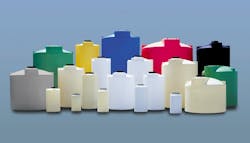Chemical-Resistant Containers Certified for Potable Water Contact
Assmann Corp. offers a line of corrosion- and chemical-resistant tanks and containers in capacities ranging from 40 to 12,000 gal, including chemical feed stations, double-wall tanks and secondary containment. Constructed from virgin high-density crosslink or FDA-compliant linear polyethylene, the tanks and containers are used to store and transport corrosive and hazardous materials. They provide low-temperature impact resistance, are ultraviolet (UV) stabilized and come in a range of capacities and colors. Custom rotational molding, accessory fittings and custom colors are available.
Assmann offers a variety of tank accessories, including all necessary secondary processing, such as fittings, vents, fill lines, heat tracing and insulation. It also is equipped to produce auxiliary metalwork—such as cradles, supports and stands—as needed.
Assmann provides quality, cost-effective storage tanks, containers, secondary containment basins and tank accessories to meet customers’ demanding wastewater or chemical storage needs. Its engineering and sales staffs are ready to provide solutions, including any needed custom molding.
Assmann received NSF certification for its linear polyethylene tanks to NSF/ANSI Standard 61: Drinking Water System Components – Health Effects. This certification is for multiple potable water contact materials up to 140°F. The company’s high-density crosslink resin tanks also have NSF 61 certification, are certified for chemical storage and are suitable for a variety of chemicals. These NSF-certified tanks include all models of vertical storage, cylindrical horizontal, free-standing horizontal leg, double-wall, open-top, industrial mini-bulk and industrial mini-drum tanks, as well as models ICB and OTCB conical-bottom storage tanks. The company’s quality management system also is ISO 9001:2015-certified. The company’s manufacturing facilities are located in Garrett, Ind., and Marshall, Texas.
